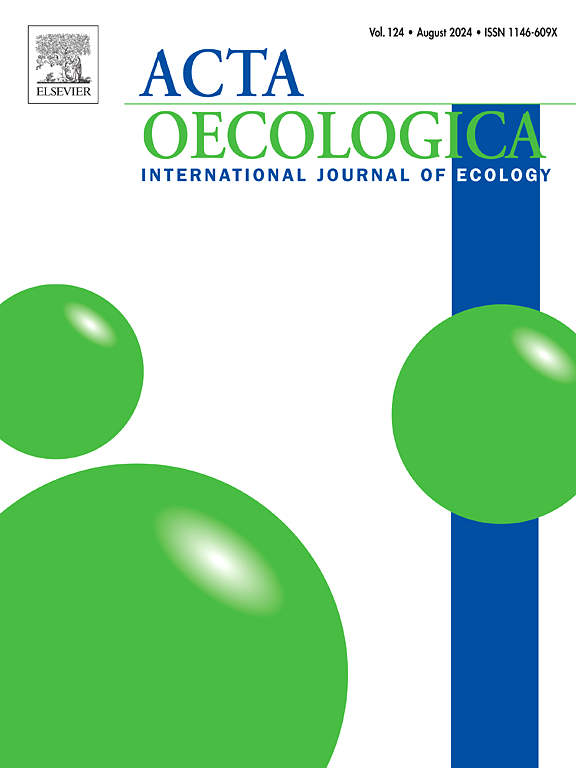Salinity effects on arbuscular mycelium network-mediated performance of Saltcedar and Camelhorn seedlings
IF 1.3
4区 环境科学与生态学
Q3 ECOLOGY
Acta Oecologica-International Journal of Ecology
Pub Date : 2025-09-23
DOI:10.1016/j.actao.2025.104127
引用次数: 0
Abstract
Arbuscular mycorrhizal fungi are important soil microorganisms that form arbuscular mycelium networks (AMN) and promote plant growth. However, reports on AMN effects on growth and physiological characteristics of desert plants under salinity are scarce. Here, we aimed to investigate the effects of salinity on AMN-mediated growth, photosynthesis, and metabolism of Saltcedar (Tamarix ramosissima) and Camelthorn (Alhagi sparsifolia) seedlings. Three salt treatments (0 %, 0.4 %, and 0.8 %, S1, S2, and S3, respectively), and two mycelial transfer distances (15 and 30 cm, L1 and L2, respectively), were tested on seeds planted in AMF-inoculated/uninoculated soil. At S1, mycorrhizal colonization promoted aboveground biomass of Saltcedar by 23.6 % (L1) and 21.8 % (L2) compared to non-inoculated plants, with chlorophyll a content elevated by 18.9 % (L1) and 17.5 % (L2), and SOD activity increased by 12.3 % (L1) and 11.8 % (L2) regardless of distance. For Camelthorn under S1, belowground biomass increased by 32.1 % (L1) and 30.5 % (L2), root length was enhanced by 27.5 % (L1) and 23.2 % (L2), and root/shoot ratio was 14.86 % higher under L1 than L2. Mycorrhizal colonization had no significant effect on F0 or Fm values of Saltcedar, nor Fm values of Camelthorn under S2 +L1. At S2+L1, AMF inoculation significantly reduced Fo values of Saltcedar by 4.5 % and increased Fm values of Camelthorn by 12.5 %. Neither growth nor physiological indexes differed between species in L2 under S2. Photosynthesis, antioxidant and osmotic regulation ability, and salt tolerance significantly improved in Saltcedar upon mycorrhizal colonization under low salinity and long distance, with chlorophyll fluorescence parameter Fv/Fm increased by 5.0 % (L1) and 4.8 % (L2). Meanwhile, root/shoot ratio and root morphological indexes improved in Camelthorn, which survived and continued to grow.
盐度对杉木和骆驼角幼苗丛枝菌丝网络调控性能的影响
丛枝菌根真菌是形成丛枝菌丝网络(AMN)、促进植物生长的重要土壤微生物。然而,盐碱化条件下AMN对荒漠植物生长和生理特性的影响报道较少。本研究旨在研究盐度对柽柳(Tamarix ramosissima)和骆驼刺(Alhagi sparsifolia)幼苗生长、光合和代谢的影响。在接种和未接种amf的土壤上,试验了3种盐处理(分别为0 %、0.4 %和0.8 %,S1、S2和S3)和2种菌丝转移距离(分别为15和30 cm, L1和L2)。在S1处,与未接种植株相比,菌根定殖使盐杉树地上生物量分别提高了23.6% (L1)和21.8% (L2),叶绿素a含量分别提高了18.9% (L1)和17.5% (L2), SOD活性分别提高了12.3% (L1)和11.8% (L2)。与L2相比,L1处理下的驼刺地下生物量增加了32.1% (L1)和30.5% (L2),根长增加了27.5% (L1)和23.2% (L2),根冠比提高了14.86%。在S2 +L1条件下,菌根定植对杉木的F0和Fm值无显著影响,对驼刺的Fm值无显著影响。在S2+L1时,接种AMF显著降低了盐杉木的Fo值4.5%,增加了骆驼刺的Fm值12.5%。在S2条件下,不同种间的生长和生理指标均无差异。在低盐度和长距离条件下,菌根定殖显著提高了盐杉的光合作用、抗氧化和渗透调节能力以及耐盐能力,叶绿素荧光参数Fv/Fm分别提高了5.0% (L1)和4.8% (L2)。与此同时,骆驼刺的根冠比和根系形态指标得到改善,存活下来并继续生长。
本文章由计算机程序翻译,如有差异,请以英文原文为准。
求助全文
约1分钟内获得全文
求助全文
来源期刊
CiteScore
3.60
自引率
0.00%
发文量
57
审稿时长
>0 weeks
期刊介绍:
Acta Oecologica is venue for the publication of original research articles in ecology. We encourage studies in all areas of ecology, including ecosystem ecology, community ecology, population ecology, conservation ecology and evolutionary ecology. There is no bias with respect to taxon, biome or geographic area. Both theoretical and empirical papers are welcome, but combinations are particularly sought. Priority is given to papers based on explicitly stated hypotheses. Acta Oecologica also accepts review papers.

 求助内容:
求助内容: 应助结果提醒方式:
应助结果提醒方式:


